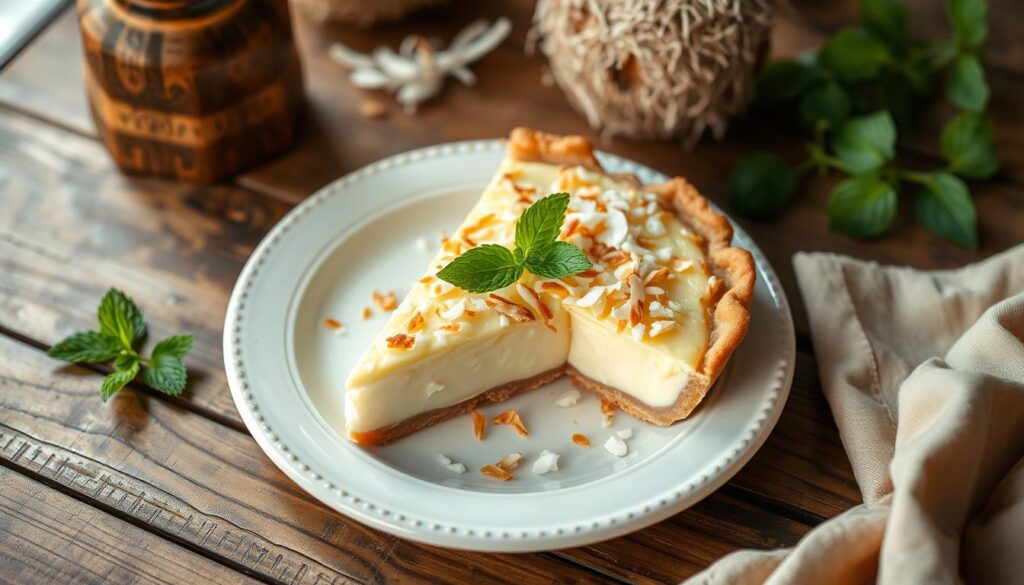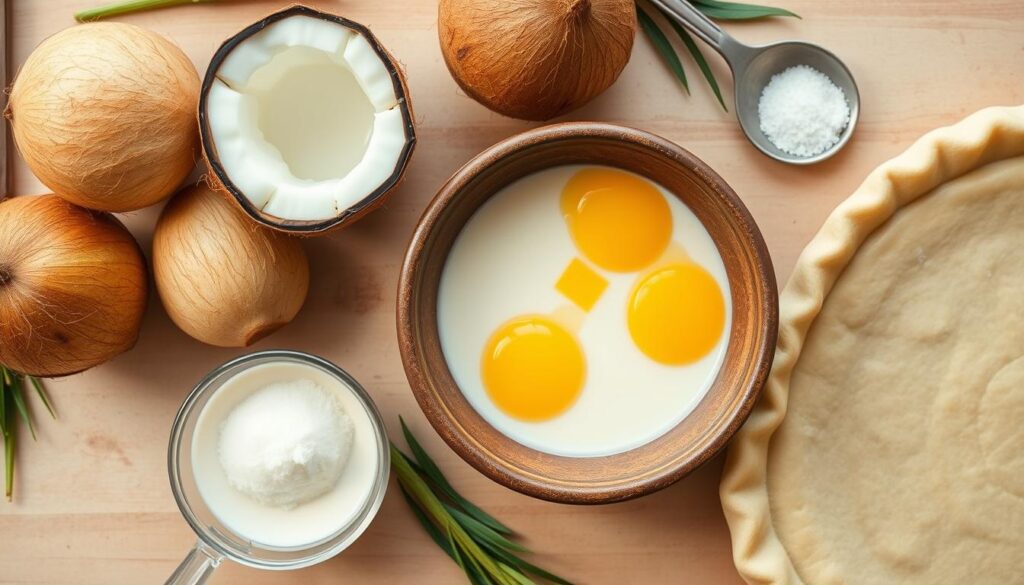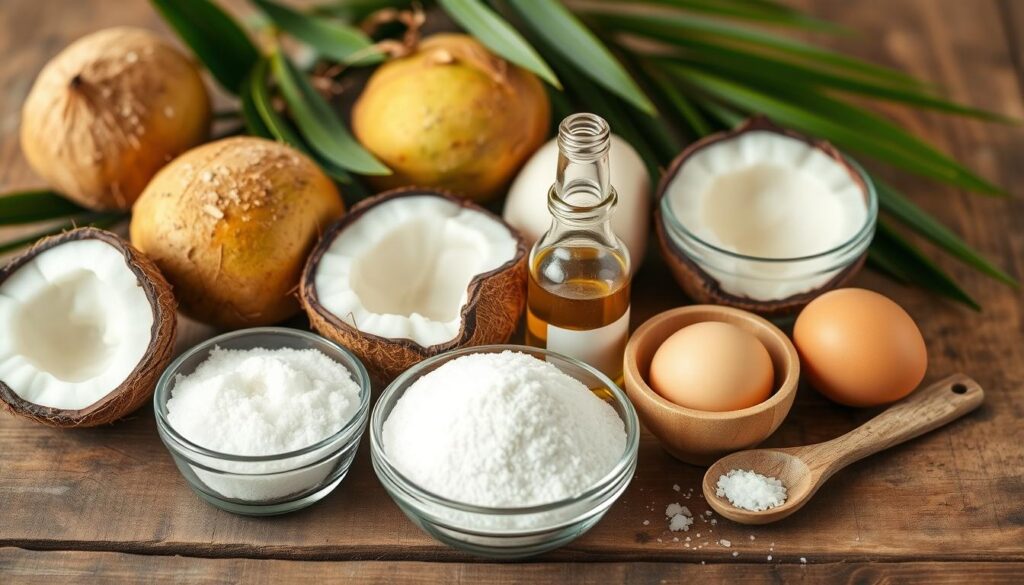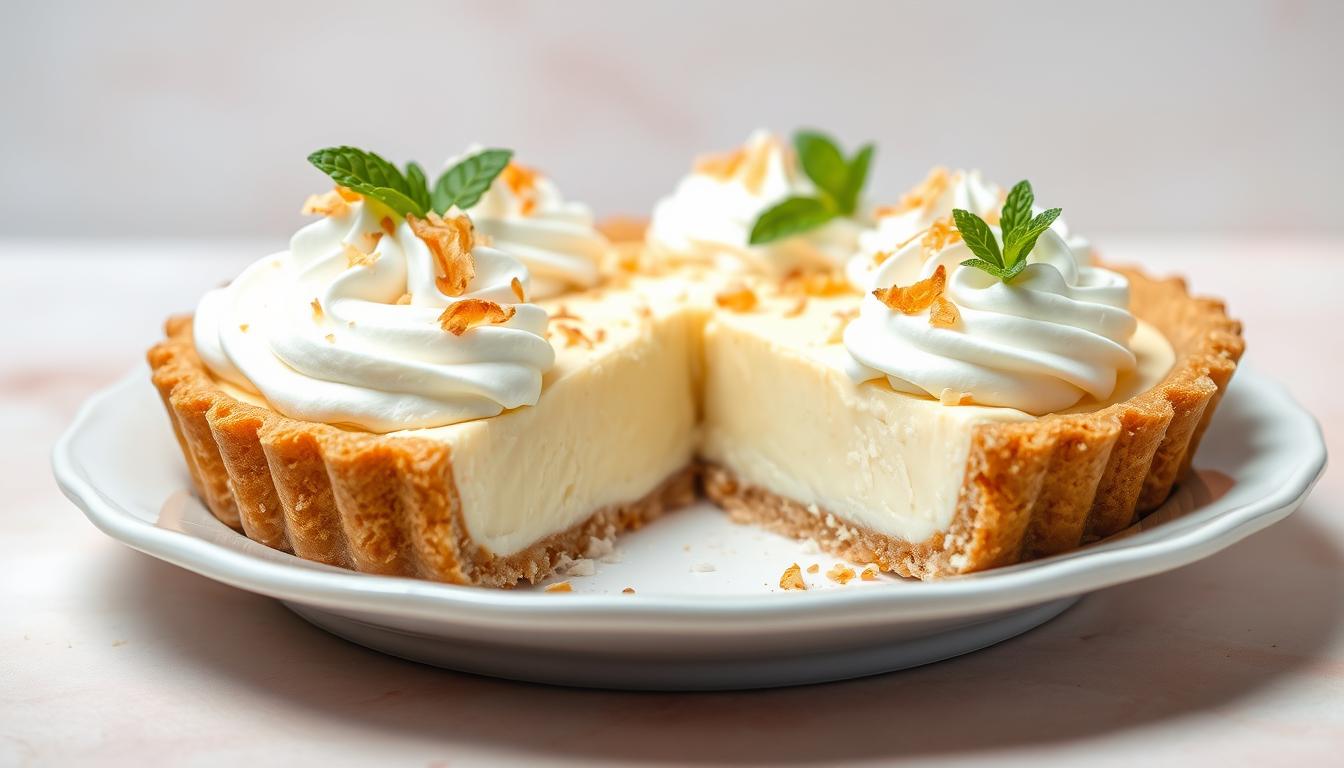I still remember my first bite of coconut custard pie. The crust was buttery and flaky. The filling was creamy and sweet, with a tropical coconut flavor. It was a moment that changed my taste buds forever.
Coconut custard pie is a true delight for anyone who loves coconut. Its mix of textures and flavors has made it a favorite for many. It’s a classic that has won hearts across generations.
Key Takeaways
- Coconut custard pie combines the richness of a custard base with the sweetness of shredded coconut.
- The recipe features a contrast between a flaky, buttery crust and a velvety smooth filling.
- Proper temperature control and mixing techniques are crucial for achieving the perfect custard consistency.
- Customizable toppings and flavor variations allow you to put your own unique spin on this timeless treat.
- Storing and making the pie ahead of time can save you time on the day of your event or gathering.
Table of Contents
Dive into the world of coconut custard pie and discover the secret to creating a velvety, indulgent dessert. This comprehensive guide covers everything from understanding the key components for success to mastering the art of the perfect custard filling. Get ready to impress your guests with our expertly crafted coconut custard pie recipe easy that will have them craving more.
- Understanding the Magic of Coconut Custard Pie
- Essential Ingredients for the Perfect Coconut Custard
- Mastering the Pie Crust Foundation
- The Ultimate Coconut Custard Pie Recipe
- Perfecting the Custard Filling Technique
- Expert Tips for Achieving Silky Texture
- Troubleshooting Common Custard Issues
- Creative Variations and Toppings
- Storage and Make-Ahead Instructions
| Baking Temperature | Baking Time | Servings | Prep Time | Cook Time | Chilling Time | Total Time | Calories | Ratings |
|---|---|---|---|---|---|---|---|---|
| 450°F (initially), then 350°F | 15 minutes (blind bake crust), 45-50 minutes (custard filling) | 12 | 15 minutes | 55 minutes | 2 hours | 3 hours 10 minutes | 256 kcal per serving | 5-star ratings from 11 votes |
Get ready to indulge in the coconut custard pie recipe easy that will transport your taste buds to a tropical paradise. With our step-by-step guide, you’ll master the art of creating this velvety dessert and impress your loved ones with your culinary skills.

Understanding the Magic of Coconut Custard Pie
Coconut custard pie and coconut cream pie are different. Coconut custard pie is baked, making it firmer and velvety. Coconut cream pie, on the other hand, is cooked on the stovetop, giving it a smoother texture.
The Difference Between Custard and Cream Pies
The main difference is how they’re made. Custard pies, like this coconut custard pie recipe with coconut milk, are baked. This makes the filling rich and custardy. In contrast, coconut cream pie recipe fillings are cooked on the stovetop, making them smoother and creamier.
Why This Recipe Works
The combination of a crisp pie crust and a silky coconut custard filling is amazing. Shredded coconut, eggs, milk, sugar, and vanilla extract make it special. It’s a treat for those who love coconut.
Key Components for Success
To make the perfect coconut custard pie, focus on these key components:
- Shredded coconut, both in the filling and as a topping, for a pronounced coconut flavor and texture
- Eggs, which provide structure and richness to the custard
- Milk, either whole or 2%, for a creamy, velvety texture
- Sugar, to balance the sweetness and enhance the coconut flavor
- Vanilla extract, for an aromatic, comforting note
- A touch of nutmeg, to add a subtle warmth and depth of flavor

Mastering these components will help you make a coconut custard pie that everyone will love.
Essential Ingredients for the Perfect Coconut Custard
Making a delicious coconut custard pie begins with picking the right ingredients. You need sweetened shredded coconut, rich dairy, and eggs. Each one is crucial for the right texture and taste.
Choosing the Right Coconut Products
The quality and type of coconut are key for a rich custard. Sweetened shredded coconut is a popular choice. But, adding unsweetened coconut flakes can boost the coconut taste.
A mix of 1 1/4 cups sweetened shredded coconut and 1/4 cup unsweetened flakes is ideal.
Dairy and Egg Selection
Full-fat milk makes the custard smooth and creamy. Eggs are essential for thickening. A recipe usually uses 6 eggs (1 whole, 4 yolks, and 1 whole for the glaze).
Egg yolks make it silky, while whole eggs help it hold its shape.
Additional Flavor Enhancers
Vanilla extract and nutmeg enhance the coconut taste. Vanilla adds a warm, comforting flavor. Nutmeg adds a subtle spice that balances the sweetness.
About 1 1/2 teaspoons of vanilla and 1/4 teaspoon of nutmeg are perfect for flavor.

With these ingredients, you’re ready to make a tasty coconut custard pie. It will wow your guests and satisfy your sweet tooth.
Mastering the Pie Crust Foundation
Creating a delicious coconut custard pie begins with the pie crust. You can make it yourself or buy it. Either way, getting the pie crust right is key to a great dessert.
To make a homemade pie crust recipe, mix flour, salt, cold butter, and ice water. Make sure the dough is cold before rolling it out. This keeps it flaky and tender.
- Chill the dough for at least 15 minutes in the refrigerator after preparation.
- Roll the dough out to 1 inch larger than the pie pan for the perfect fit.
- Blind bake the crust by lining it with foil and using pie weights or dried beans to prevent shrinkage.
For a quicker option, try a store-bought crust. Marie Callender’s has many choices, like traditional and graham cracker. These can save time but still taste great with your grandma’s coconut cream pie.
“The secret to a perfect pie crust is keeping the ingredients cold and handling the dough as little as possible.”
Whether you make it yourself or buy it, mastering the pie crust is crucial. With the right steps, you’ll make a pie that wows everyone. It’s a delicious start to your dessert journey.
The Ultimate Coconut Custard Pie Recipe
Indulge in the velvety goodness of a best coconut custard pie recipe that’s truly out of this world. This old-fashioned coconut custard pie is a classic dessert that’s sure to delight your taste buds. With its flaky crust, creamy custard filling, and irresistible coconut topping, this pie is a must-try for any coconut lover.
To start, you’ll need to blind bake a 9-inch deep dish pie crust. Once the crust is golden, it’s time to layer in the magic. Begin by sprinkling 1 cup of sweetened shredded coconut over the bottom of the crust. This will create a delightful textural contrast as the custard sets.
For the custard filling, you’ll whisk together 3 large eggs, 3/4 cup of sugar, 1 2/3 cups of 2% milk, 2 teaspoons of vanilla extract, and a pinch of salt. Pour this mixture over the coconut layer, ensuring it’s evenly distributed.
Bake the pie at 350°F for 45 to 50 minutes, or until the center is set but still slightly jiggly. Allow the pie to cool completely before topping it with a dollop of whipped cream or meringue and a sprinkle of the remaining 1/2 cup of sweetened shredded coconut.
This old fashioned coconut custard pie recipe is perfect for any occasion, from family gatherings to holiday celebrations. Serve it chilled or at room temperature, and enjoy the delightful combination of creamy custard and toasted coconut in every bite.
Whether you’re a seasoned baker or a novice in the kitchen, this best coconut custard pie recipe is sure to impress. With its easy-to-follow instructions and perfectly balanced flavors, it’s a dessert that will leave your guests asking for seconds. So, gather your ingredients and get ready to create a true masterpiece in the kitchen!
Perfecting the Custard Filling Technique
Making the perfect coconut custard pie begins with mastering the custard filling. It’s all about balancing flavors and textures. You need to control the temperature, mix carefully, and check if it’s done right. Follow these steps for a silky-smooth custard that pairs well with the buttery coconut crust.
Temperature Control Tips
Tempering eggs is key to avoid curdling. Start by whisking a bit of hot milk into the eggs. Then, slowly add the egg mix back into the pan. This method ensures the eggs cook evenly without scrambling.
The custard should thicken in 5-7 minutes. Then, boil it for 1 minute to set the proteins fully.
Proper Mixing Methods
- Stir the custard gently with a whisk or wooden spoon as it cooks. Be careful not to over-mix.
- Lightly fold in the melted butter and coconut flakes into the custard base. This keeps it smooth and velvety.
- Let the pie crust cool completely before filling. This prevents the crust from getting soggy.
Testing for Doneness
The pie is ready when a knife inserted in the center comes out clean. This usually takes 45-50 minutes of baking. The custard should be set but still slightly jiggly in the center. Avoid overbaking to prevent a dry filling.
By mastering these techniques, you’ll get a coconut custard pie with a silky texture and rich flavor. With practice, making this dessert will become second nature.
Expert Tips for Achieving Silky Texture
Creating a velvety, smooth coconut custard recipe is all about temperature control and precise techniques. Follow these expert tips to ensure your coconut custard pie has a luxurious, silky texture that will delight your taste buds.
- Monitor Temperature Closely: Proper temperature control is crucial when cooking the custard. Use a reliable oven thermometer to ensure your oven maintains the ideal baking temperature of 375°F (190°C).
- Strain for a Lump-Free Filling: Before pouring the custard into the prepared pie crust, be sure to strain it through a fine-mesh sieve. This will remove any small lumps or impurities, resulting in a silky-smooth texture.
- Allow Complete Cooling: Let the custard filling cool completely before adding it to the pie crust. Pouring a warm custard into the shell can lead to a soggy bottom, so patience is key.
- Use a Water Bath: Baking the coconut custard pie in a water bath, also known as a bain-marie, helps ensure even heat distribution and prevents cracking or curdling of the custard.
By following these expert tips, you’ll be well on your way to creating a coconut custard recipe with a velvety, smooth texture. This will impress your guests and satisfy your sweet tooth.
Troubleshooting Common Custard Issues
Making the perfect coconut custard pie recipe is an art. Even skilled bakers face challenges. But, with a few tips, you can solve common problems and get a smooth, creamy pie every time.
Preventing Curdling
Curdling is a big problem with custard. It happens when the mixture separates. To avoid this, temper the eggs slowly. Whisk a bit of hot custard into the egg yolks before mixing it back into the pan.
This method helps the eggs adjust to the heat. It keeps the custard smooth and creamy.
Fixing Texture Problems
- If your custard isn’t thick, heat it to about 190°F (88°C) to set it.
- For a watery custard, cook it longer until it’s thick like pudding.
- If meringue weeps, add cornstarch and cream of tartar to fix it.
Addressing Baking Concerns
Getting your coconut custard pie to bake right is key. Watch the oven temperature closely. Fluctuations can cause problems like a cracked or too brown crust. Bake at a steady 325°F (165°C) for the best results.
“Mastering custard-making is about precision and patience. With a few techniques, your coconut custard pie will be incredibly creamy and delicious.”
By solving common custard issues, you’ll make a memorable coconut custard pie. Your guests will love it. With the right steps, your dessert will be a hit.
Creative Variations and Toppings
Get creative with your coconut pie recipe or coconut cream pie recipe. Try using coconut extract instead of vanilla. Or, make a crustless version for a unique twist.
Add a toasted coconut topping for a crunchy texture. Or, use whipped cream for a creamy, indulgent touch.
Top your coconut pie with tropical fruits like pineapple or mango. Or, drizzle it with caramel sauce or sprinkle with dark chocolate.
Be your own pastry artist with your coconut custard pie. Try new flavors and toppings. Let your imagination run wild!
| Variation | Description |
|---|---|
| Coconut Extract Pie | Swap vanilla extract for coconut extract to amplify the tropical flavor. |
| Crustless Coconut Pie | Eliminate the pie crust for a lighter, gluten-free option. |
| Toasted Coconut Topping | Top the pie with golden, crunchy toasted coconut flakes. |
| Whipped Cream Topping | Replace the meringue with a cloud-like whipped cream topping. |
| Fruit Garnishes | Adorn the pie with sliced tropical fruits like pineapple, mango, or kiwi. |
| Caramel Drizzle | Finish the pie with a decadent caramel sauce drizzle. |
| Chocolate Shavings | Sprinkle the pie with delicate chocolate shavings for a touch of elegance. |
Explore the endless possibilities of your coconut cream pie recipe. Be your own culinary artist. Try new flavors and toppings. Let your creativity shine!
Storage and Make-Ahead Instructions
Proper storage and make-ahead techniques are key for the coconut custard pie. This dessert is easy to prepare ahead of time. This way, you can enjoy its creamy texture and coconut flavor whenever you want.
The baked pie can stay in the fridge for 3-4 days if covered well. The pie crust can be frozen for up to 2 months. Just roll out the dough, put it in a freezer-safe bag or airtight container, and freeze until needed.
But, don’t freeze the whole pie. The filling and topping might separate when thawed. For the best taste and texture, serve the pie within 1-2 days. With some planning ahead, you can have this pie ready for any craving!

